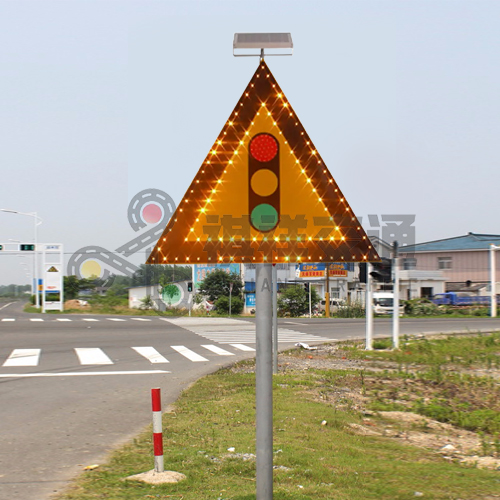In recent years, solar traffic signs have become increasingly popular as a sustainable and efficient traffic management solution. The signs are equipped with solar panels that use the sun’s energy to operate, making them an environmentally friendly alternative to traditional grid-powered signs. In this article, we’ll explore how solar traffic signs work and how they can contribute to a more sustainable traffic management system.
The working principle of solar traffic signs is quite simple yet ingenious. These signs are equipped with photovoltaic (PV) cells, often called solar panels, that convert sunlight into electricity. This electricity is then stored in rechargeable batteries to power the sign’s LED lights and any other electronic components.
Photovoltaic cells produce direct current when sunlight hits a solar panel. The inverter then converts the electrical energy into alternating current (AC) to power the LED lights on the traffic signs. At the same time, excess electricity generated by the solar panels is stored in the battery, providing backup power when sunlight is insufficient.
There are several advantages to using solar energy for traffic signs. First, it reduces reliance on the grid, making solar traffic signs a more sustainable and cost-effective solution. With the growing emphasis on renewable energy, solar traffic signs align with the global push for a greener, more sustainable future.
Additionally, solar traffic signs offer greater flexibility in placement since they do not need to be connected to the grid. This means they can be installed in remote areas, construction sites, or rural areas where grid access may be limited or non-existent. This makes them an ideal solution for temporary traffic management needs such as roadworks or active signage.
Additionally, solar traffic signs contribute to overall safety and visibility for road users. The LED lights used in solar traffic signs are highly visible even in low-light conditions, ensuring that drivers and pedestrians can easily see and interpret the information displayed on the sign. This is particularly important for traffic management and safety, as clearly visible signage is vital to preventing accidents and keeping traffic flowing.
In addition to practical benefits, solar traffic signs also have significant environmental advantages. By harnessing solar energy, these signs reduce fossil fuel consumption and minimize the carbon footprint associated with traditional grid-powered signs. This helps create a cleaner, more sustainable environment, in line with global efforts to combat climate change and reduce greenhouse gas emissions.
While the working principle of solar traffic signs is relatively simple, the technology behind them is still evolving. Advances in solar panel efficiency, battery storage capacity, and LED lighting technology are continuing to improve the performance and reliability of solar traffic signs. This means that these signs are not only a sustainable solution but also a practical and efficient solution to traffic management needs.
To sum up, the working principle of solar traffic signs is to use the energy of the sun to generate electricity through photovoltaic cells. This sustainable and efficient solution offers numerous benefits, including cost-effectiveness, layout flexibility, enhanced security and visibility, and environmental sustainability. As the demand for sustainable, efficient traffic management solutions continues to grow, solar traffic signs will play an increasingly important role in shaping the future of traffic and road safety.
If you are interested in solar traffic signs, welcome to contact manufacturer Qixiang to get a quote.
Post time: Dec-26-2023







